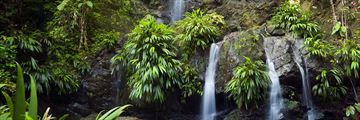The best birdwatching spots in Tobago
With its beautiful beaches and tropical rainforests, it’s no wonder Tobago is an oasis for exotic, colourful birdlife. Explore the island’s incredible sceneries and you’ll be sure to find plenty of indigenous birds swooping over your head, chirping gleefully in their natural habitat. With over 260 species of bird, Tobago’s birdwatching is wonderfully rewarding. But where should you go for the best views of these beautiful creatures? We’ve collated the best spots in Tobago birdwatching enthusiasts will love.

Before we begin with where to go, first you need to decide when to visit. December to April is the best time to spot a wide variety of birds, especially in the spring when the birds stop in Tobago during their migration to North America. No matter when you decide to visit Tobago though, you’ll be treated to wonderful bird sightings wherever you go, as there are many beautiful birds that reside on the island year-round.
When it comes to where to stay, Castara Retreats is one of our top choices. Located close-by to the charming Castara Village, this hotel boasts 17 lovely eco-lodges nestled within mango trees and rainforest – the perfect setting for spotting birds whilst relaxing on your balcony. Relishing the slower pace of life, we love that Castara Retreats focuses on sustainability. Wake to the sound of birdsong, look for hummingbirds buzzing by while you relax in your hammock, and of course enjoy excellent birdwatching excursions nearby.

For a little slice of paradise, we suggest exploring the fascinating Little Tobago – a picturesque, small island that sits near the north-eastern coast of Tobago. With beautiful, crystal clear reefs surrounding it, this is the perfect spot for snorkelling and reef tours, but venture onto land and you’ll spot a myriad of birds soaring above. Red Footed and Browned Boobies make this area their home all year round, but mid-October is the best time to visit thanks to the arrival of the majestic Red Billed Tropic Birds and Audubon Shearwaters. The already vibrant area is made even more so by the arrival of the bright rose-coloured Roseates that migrate here in August and September, as well as the magnificent Peregrine Falcon, Merlins, Osprey and Bridles that fly around during this time, too.

Adorable Blue Backed Manakin, emerald green White Tailed Sabrewing Hummingbirds and the funky patterned Red Crowned Woodpecker add a spot of vibrant colour to the Tobago rainforests, providing a stark contrast to the luscious, exotic trees they fly between. Explore any of the island’s verdant jungles and you really won’t be disappointed with the variety of winged creatures you encounter. The variety is huge too - from Stripe Breasted Spinetail and Streaked Flycatchers, to the Green Kingfisher and the Common Potoo, you’ll be ticking plenty from your list as you listen to the crescendo of bird calls that surround the landscapes.
Stroll through Gilpin Trace, the oldest and most prestigious trail in UNESCO-listed Tobago Main Ridge Forest Reserve, and you’ll be rewarded with incredible birdwatching and natural beauty. The Forest Reserve is the oldest nature reserve in the western hemisphere, and so there is lots of wonderful flora that has established over many years. You may spot one of the world’s rarest hummingbirds, the white-tailed sabrewing, as well as blue-backed manakins and the white necked jacobin.
The Main Ridge Forest Reserve is also a beautiful birdwatching spot. Here you may see the streak flycatcher, the Trinidad motmot, and even land animals including agouti.

It’s not just the rainforests though - the wetlands in Tobago, including the island’s plantation areas, are abundant in characterful ducks. It’s not just the ducks you find in England either, instead you’ll be able to explore the area amongst Black Bellied Whistling Ducks, Caribbean Coots, Least Grebe, and even Masked ducks with their intricately patterned feathers and baby blue beaks.
You’ll find an abundance of other beautiful birds in the wetlands, too. Many magnificent heron species flock here, including Great Blue Herons and Yellow Crowned Night Heron, who wander through the marshlands in search of succulent fish. The egrets that saunter here are just as majestic, their long limbs and wings daintily gliding along the waters, and you’ll catch a glimpse of bright Yellow Warblers bouncing amongst the trees too.

The Caroni Swamp also provides excellent bird sanctuary tours – a sure fire way to witness some of the bird’s natural beauty. The swamp is home to 186 species, including herons, egrets and kingfishers, so you’ll be sure to encounter a few of these winged creatures, or maybe even the resident bird, Scarlet Ibis. With incredibly intense coral feathers and a similar stature as a heron, these birds are truly beautiful, and you definitely won’t miss them amongst the muggy coloured swamps.
Photographers will rejoice at the Adventure Farm & Nature Reserve, which is home to numerous gorgeous hummingbird varieties, including the Copper-Rumped and the Black-Throated Mango. You’ll also see stunning butterflies fluttering past you, and iguanas hiding within the lush flora.
Get your lens at the ready, as Tobago is also home to a plethora of nocturnal birds. Our favourite spot in the evening is Flagstaff Hill, which overlooks St Giles and offers phenomenal nocturnal bird viewing, including the white-tailed nightjar. The elusive striped owl also resides in Tobago, which we’re sure is high on many avid bird watcher’s lists.

More Inspiration
Recommended holidays










